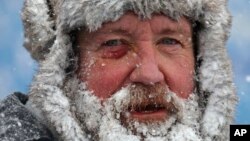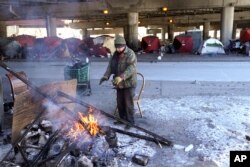Many parts of the world have experienced record-high temperatures in recent days.
But much of the United States is dealing with extremely cold weather, thanks to what is known as a polar vortex.
A map showing world temperatures over the last several days had a dark red color in the Arctic, Asia, the Middle East, South America and parts of Africa. The dark red means the temperatures are 7 degrees Celsius warmer than the average from just over 20 years ago.
The United States is one of the only places on the map that is dark blue, meaning very cold.
In the state of North Dakota, wind chills reached minus 56 degrees Celsius. Last week in the state of Missouri, a professional American football game took place as temperatures dropped to minus 20 degrees Celsius.
On the other side of the world, the world’s top tennis players are playing in unusually warm weather in Melbourne, Australia. The Australian Open is taking place as the city records temperatures nearly 7 degrees warmer than average.
The African nation of Oman is in the northern hemisphere, where it is winter. It recently set a record for the warmest January night at 26.4 Celsius. Parts of the southern hemisphere are experiencing warmer-than-usual weather, too. Argentina set a record for warmest January night at 27.3 degrees Celsius.
Climate scientists say these extreme temperatures are due to warming in the Arctic.
They say warming temperatures in the Arctic affect the weather all around the world. The pattern called a polar vortex is not unusual in the Arctic. However, experts say as temperatures in the north warm, the polar vortex widens and affects Canada and the United States.
Jennifer Francis is with the Woodwell Research Center in Massachusetts. She is a leading researcher in the theory of Arctic Amplification, which links the periods of cold weather to climate change.
She said, “When the Arctic is off-the-charts warm (like now), we’re more likely to see frigid cold invade places like Texas that are ill-equipped to deal with it,” she said.
Francis added, “Rapid Arctic warming is one of the clearest symptoms of human-caused climate change.”
Judah Cohen works for Atmospheric Environmental Research, a commercial weather company near Boston, Massachusetts. He compared the polar vortex to an ice skater doing a spin.
When a skater spins very quickly, the “vortex” winds stay close to the skater. But if the skater slows down, the winds lose their tight circle.
“All the cold air then gets released away from the center of the polar vortex,” Cohen said.
When that happens in January, the target of the cold air is the United States. Cohen said the current polar vortex is stronger and longer lasting than usual.
Marshall Shepherd is a meteorology professor at the University of Georgia. He said that right now, there is a “complex interaction within our climate system.”
“Winter will always bring us cold weather, but like the warm season, it may be changing [in] ways that we understand and [in] ways that we are still learning about,” Shepherd said.
The weather experts said the extreme cold in the U.S. will change to unusually warm weather in several days. But another polar vortex is expected to hit at the end of January.
I’m Dan Friedell.
Dan Friedell adapted this story for Learning English based on a report by the Associated Press.
_______________________________________________
Words in This Story
wind chill –n. a measurement of cold based on the wind speed and temperature outside
off-the-charts –expression. not able to be measured based on expected numbers
frigid –adj. extremely cold
spin –v. to move in circular motion on a central point
meteorology –n. the study of weather and weather patters
interaction –n. the combination of two things when mixed
We want to hear from you. How is the weather where you live? Send us a photo!













Forum